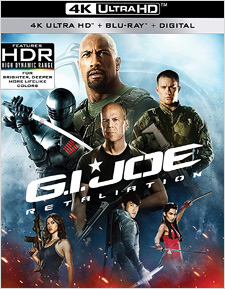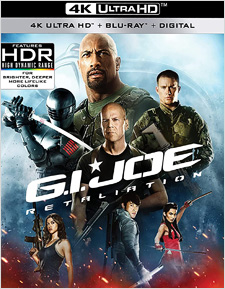G.I. Joe: Retaliation (4K UHD Review)

Director
Jon M. ChuRelease Date(s)
2013 (July 20, 2021)Studio(s)
Hasbro/Paramount Pictures/MGM (Paramount Home Entertainment)- Film/Program Grade: C+
- Video Grade: A-
- Audio Grade: A
- Extras Grade: B
Review
Since G.I. Joe: The Rise of Cobra was only moderately successful in 2009, four years later it received both a direct sequel and a soft reboot with G.I. Joe: Retaliation. The story does continue from the concluding events of Cobra and it carries forward a few of the old characters, but it quickly introduces a twist which allows the film to follow a new set of characters—and more importantly, a new set of actors, one of whom had substantially more box office clout. That didn’t necessarily translate into ticket sales, however, and the film’s worldwide grosses were only a bit higher than Cobra’s. As a result, the franchise lay dormant until it was rebooted yet again in 2021 as Snake Eyes: G.I. Joe Origins.
The story for Retaliation is a bit more interesting than in Cobra, primarily because of its willingness to take a franchise rooted in fantasy and move it through real-world geopolitics—and screenwriters Rhett Reese and Paul Wernick weren’t afraid to go apocalyptic for the finale. Cobra agent Zarton (Arnold Vosloo) is still in disguise as the President of the United States (Jonathan Pryce), and he hatches a scheme to get the Joes out of his way so that he can free Cobra Commander (Luke Bracey) and launch their plans for global domination. Only a small group of renegade Joes stand in their way: Roadblock (Dwayne Johnson), Lady Jaye (Adrianne Palicki), Flint (D.J. Cotrona), and Snake Eyes (Ray Park), with a few unexpected allies along the way. The cast is adequate at best, though Pryce is clearly having a field day playing Arnold Vosloo playing Jonathan Pryce. There’s also a memorable cameo from the always reliable Walton Goggins.
The action scenes have some tradeoffs compared to The Rise of Cobra. On the one hand, they’re staged more practically, with less reliance on CGI, and the digital effects that are present are much more convincing. On the other hand, they’re also more reliant on shaky camerawork and quick cutting, so they’re a bit less coherent. On the balance, the greater visual realism in this film probably has the edge despite the chaotic camerawork. Some of the effects are also surprisingly good, with an extremely convincing shot featuring the two Jonathan Pryce characters—it’s easy to suspend disbelief and accept that they are both there at the same time.
G.I. Joe: Retaliation is hardly a groundbreaking film, but it’s enjoyable enough for what it is. It’s a bit more down-to-earth than The Rise of Cobra was, though that’s a matter of degrees when talking about high fantasy like this. Again, this isn’t a franchise which is meant to be taken seriously, so it’s best viewed on its own terms.
Cinematographer Stephen F. Windon shot G.I. Joe: Retaliation on film in Super 35 format using ARRIFLEX 235 & 435 cameras (as well as Panavision Panaflex Millennium XL2 cameras) with Panavision Primo spherical lenses. The film was originally finished as a 2K Digital Intermediate, framed at 2.39:1 for its theatrical release. For this Ultra HD version, Paramount rescanned the original camera negative in native 4K and upsampled the 2K VFX footage to create a new 4K DI, complete with new grading for high dynamic range—both Dolby Vision and HDR10 are included on the disc. The improvements are more noticeable here than for The Rise of Cobra, though they’re still pretty subtle. It’s just a bit sharper and more detailed compared to the Blu-ray, but the differences will be negligible on most displays. The HDR grade offers a bigger upgrade, with more saturated colors, and brighter highlights for lights and explosions. The black levels are elevated compared to The Rise of Cobra, but they also allow for more shadow detail compared to the crushed blacks on that disc. Overall, it’s a mixed bag, but still a slight improvement compared to the Blu-ray.
Primary audio is the same English 7.1 Dolby TrueHD mix from previous releases. While an Atmos remix might have enhanced the experience, there’s nothing to complain about with this track—it’s an aggressive mix, with powerful dynamics and strongly directional effects in the surrounds, as well as some thunderous bass. This was a reference quality mix prior to the introduction of Atmos, and it’s still reference quality by today’s standards. Additional audio options include English Descriptive Audio, German, Spanish (Spain), Spanish (Latin America), French, French (Canada), Italian, Japanese, Portuguese (Brasil), and Russian 5.1 Dolby Digital. Subtitle options include English, English SDH, Cantonese, Danish, German, Spanish (Spain), Spanish (Latin America), French, French (Canada), Italian, Japanese, Korean, Mandarin, Dutch, Norwegian, Portuguese (Brasil), Russian, Simplified Chinese, Finnish, Swedish, and Thai. Audio commentary subtitles include English, German, Spanish (Spain), Spanish (Latin America), French, French (Canada), Italian, Japanese, Korean, Portuguese (Brasil), and Russian.
Paramount’s Ultra HD release of G.I. Joe: Retaliation is a 2-Disc set which includes the previous Blu-ray, a Digital Copy code on a paper insert, and a slipcover. The UHD carries over the commentary track, but the rest of the legacy features are on the Blu-ray only—all of them in HD:
DISC ONE: UHD
- Audio commentary by Jon M. Chu and Lorenzo Di Bonaventura
DISC TWO: BD
- Audio commentary by Jon M. Chu and Lorenzo Di Bonaventura
- Deleted Scenes (3 in all – 3:58)
- G.I. Joe: Declassified – Mission Briefing (10:02)
- G.I. Joe: Declassified – Deployment (8:06)
- G.I. Joe: Declassified – Two Ninjas (7:34)
- G.I. Joe: Declassified – The Desert Attack (8:25)
- G.I. Joe: Declassified – Cobra Strikes (8:57)
- G.I. Joe: Declassified – The Lone Soldiers (7:43)
- G.I. Joe: Declassified – The Monastery (9:56)
- G.I. Joe: Declassified – Fort Sumter (12:09)
The commentary track with Chu and di Bonavantura is a reasonably informative one, though like the track with Stephen Sommers and Bob Duscay for The Rise of Cobra, the two are far more satisfied with the film than most viewers will be. They share production anecdotes while discussing actors, locations, action scenes, story choices, and visual effects. There’s not much here that isn’t covered in the Declassified featurettes, though they save the most interesting anecdote for last—apparently the logo for di Bonaventura’s production company was designed by none other than Steven Soderbergh. The deleted scenes include three which can be played individually or as a group, one of which shows the assassination of the Pakistani President which is only referenced in the final cut. G.I. Joe: Declassified is an eight-part collection of featurettes that can be played individually or as a group. They include interviews with Chu, di Bonaventura, and other members of the cast and crew. Mission Briefing covers the origins of the project, the story, the design work, Chu’s hiring, the decision to dial back the fantasy nature of the action from the first film, and the New Orleans locations, including the massive NASA facility featured prominently in the film. Deployment shows the pre-viz process, planning the action scenes, the pre-production stunt training, and also talks to the military advisors who were used. At one point, it gives a nice behind-the-scenes look at an old-school Texas Switch. Two Ninjas looks at the dojo fight between Snake Eyes and Jinx, and it gives an opportunity to see Ray Park without the mask. The Desert Attack shows the Louisiana location used for the attack on the Joes near the beginning of the film, and explains how the action was staged. Chu also talks about why he hired Fast & Furious franchise cinematographer Windon. Cobra Strikes covers the underground prison set, how the film further explored the character of Storm Shadow, the addition of Firefly, the redesign of Cobra Commander, the creation of the Cobra Command set, and how crucial Jonathan Pryce was to the film. The Lone Soldiers looks at how the new group of characters develop after the desert attack, including how Bruce Willis became involved. The Monastery focuses on the monastery set, showing the staging of the fight between Snake Eyes and Storm Shadow, as well as the fight between Lady Jaye and the medicine woman. It also shows how the swinging rope fight with the Red Ninjas was shot. While that may be one of the most CGI-heavy sequences in the film, it’s surprising how few digital doubles were used. Fort Sumter covers the finale of the film shot at Fort Pike, the nuclear summit sequence, the vehicles created for the production, and the final fight between Roadblock and Firefly. Overall, this is a solid collection of extras, even though they gloss over any negative details.
Paramount’s Ultra HD release of G.I. Joe: Retaliation may not win over any new fans, but it offers a mild upgrade for existing ones, or for anyone who can accept competent franchise filmmaking at face value. It’s diverting enough.
- Stephen Bjork
(You can follow Stephen on social media at these links: Twitter and Facebook)

